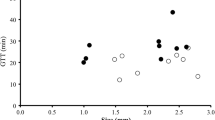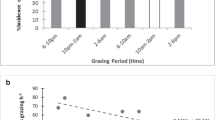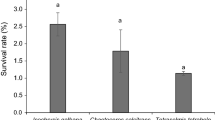Abstract
Four different methods were used in the control conditions of laboratory to estimate the ingestion rate of a female meiobenthic harpacticoid copepod Amonardia normani: (1) reduction of algal biomass, (2) the quantification of total pigments in fecal pellets, (3) the gut fluorescence method, (4) the percentage of assimilation and the total egestion rate. The food used during all experiments was the diatom Nitzschia constricta in an axenic condition at the concentration of 0.13 μg Chl-a mL−1 at stationary growth phase. All experiments were made at 20 °C and 30 salinity. All tested methods excepted the quantification of total pigments in fecal pellets resulted in similar estimatives. The gut fluorescence method indicated that during the day gut contents are smaller than during the night but the gut passage time was faster, resulting in similar ingestion rates during the day and the night. The reduction of algal biomass and the percentage of assimilation and the total egestion rate also indicated similar ingestion rates in the day and in the night. The daily ingestion rate represents 107 % of female carbon weight per day (903 ng C cop−1day−1).

Similar content being viewed by others
References
Baars MA, Oosterhuis SS (1984) Diurnal feeding rhythms in North Sea copepods measured by gut fluorescence, digestive enzyme activity and grazing on labelled food. Neth J Sea Res 18:97–119
Betouhim-El T, Kahan D (1972) Tisbe pori n. sp. (Copepoda: Harpacticoida) from the Mediterranean Coast of Israel and its cultivation in the laboratory. Mar Biol 16:201–209
Blanchard GF (1991) Measurement of meiofauna grazing rates on microphytobenthos: is primary production a limiting factor? J Exp Mar Biol Ecol 147:37–46
Brown TJ, Sibert JR (1977) The food of some benthic harpacticoid copepods. J Fish Res Board Can 34:1028–1031
Buffan-Dubau E, Castel J (1996) Diel and seasonal vertical distribution of meiobenthic copepods in muddy sediments of a eutrophic lagoon (Fish Ponds of Arcachon Bay). Hydrobiologia 329:69–78
Castel J (1979) Adaptation and reproductive cycle of the harpacticoid copepod Amonardia normani (Brady 1872) in semi-enclosed lagoons of Arcachon Bay, France. In: Naylor E, Hartnoll G (eds) Cyclic phenomena in marine plants and animals. Pergamon Press, Oxford, pp 131–138
Castel J (1985) Importance des copépodes méiobenthiques lagunaires dans le régime alimentaire des formes juvéniles de poissons euryhalins. Bull Ecol 16:169–176
Castel J (1992) The meiofauna of coastal lagoon ecosystems and their importance in the food web. Vie Milieu 42:125–135
Castro ALC, Diniz AF, Martins IZ, Vendel AL, Oliveira TPR, Rosa IML (2008) Assessing diet composition of seahorses in the wild using a non destructive method: Hippocampus reidi (Teleostei: Syngnathidae) as a study-case. Neotrop Ichthyol 6:637–644
Christoffersen K, Jespersen AM (1986) Gut evacuation rates and ingestion rates of Eudiaptomus graciloides measured by means of the gut fluorescence method. J Plankton Res 8:973–983
Conover RJ (1966) Factors affecting the assimilation of organic matter by zooplankton and the question of superfluous feeding. Limnol Oceanogr 11:346–354
Coull BC (1990) Are members of the meiofauna food for higher trophic levels? Trans Am Microsc Soc 109:233–246
Coull BC, Giere O (1988) The history of meiofaunal research. In: Higgins RP, Thiel H (eds) Introduction to the study of meiofauna. Smithsonian Institution Press, Washington, pp 14–17
Decho AW (1986) Water-cover influences on diatom ingestion rates by meiobenthic copepods. Mar Ecol Prog Ser 33:139–146
Decho AW (1988) How do harpacticoid grazing rates differ over a tidal cycle? Field verification using chlorophyll-pigment analyses. Mar Ecol Prog Ser 45:263–270
Durbin EG, Campbell RG (2007) Reassessment of the gut pigment method for estimating in situ zooplankton ingestion. Mar Ecol Prog Ser 331:305–307
Durbin AG, Durbin EG, Wlodarczyk E (1990) Diel feeding behaviour in the marine copepod Acartia tonsa in relation to food availability. Mar Ecol Prog Ser 68:23–45
Gee JM (1989) An ecological and economic review of meiofauna as food for fish. Zool J Linn Soc 93:243–261
Giere O (2009) Meiobenthology: the microscopic motile fauna of aquatic sediments, 2nd edn. Springer, Berlin
Gilat E (1967) On the feeding of a benthonic copepod, Tigriopus brevicornis O. F. Müller. Bull Sea Fish Res Sta Haifa 45:79–95
Guidi L (1984) The effect of food composition on ingestion, development, and survival of a harpacticoid copepod, Tisbe cucumariae Humes. J Exp Mar Biol Ecol 84:101–110
Head JH (1992) Gut pigment accumulation and destruction by arctic copepods in vitro and in situ. Mar Biol 112:583–592
Kiørboe T, Tiselius PT (1987) Gut clearance and pigment destruction in a herbivorous copepod, Acartia tonsa, and the determination of in situ grazing rates. J Plankton Res 9:525–534
Kiørboe T, Mohlenberg F, Riisgard HU (1985) In situ feeding rates of planktonic copepods: a comparison of four methods. J Exp Mar Biol Ecol 88:67–81
Lang K (1988) Monographie der Harpacticiden I und II, reprint. Otto Koeltz Science Publisher, Koenigstein
Lonsdale DJ, Levinton JS (1989) Energy budgets of latitudinally separated Scottolana canadensis (Copepoda : Harpacticoida). Limnol Oceanogr 34:324–331
Lorenzen CJ (1966) A method for the continuous measurement of in vivo chlorophyll concentration. Deep-Sea Res 13:223–227
Lorenzen CJ (1967) Determination of chlorophyll and pheopigments: spectrophotometric equations. Limnol Oceanogr 12:343–346
Mackas D, Bohrer R (1976) Fluorescence analysis of zooplankton gut contents and an investigation of diel feeding patterns. J Exp Mar Biol Ecol 25:77–85
Mayzaud P, Razoul S (1992) Degradation of gut pigment during feeding by a subantarctic copepod: importance of feeding history and digestive acclimation. Limnol Oceanogr 37:393–404
McCall JN, Fleeger JW (1995) Predation by juvenile fish on hyperbenthic meiofauna: a review with data on post-larval Leiostomus xanthurus. Vie Milieu 45:61–73
McIntyre AD, Murison DJ (1973) The meiofauna of a flatfish nursery ground. J Mar Biol Ass UK 53:93–118
Montagna PA (1984) In situ measurement of meiobenthic grazing rates on sediment bacteria and edaphic diatoms. Mar Ecol Prog Ser 18:119–130
Nilsson P, Sundbäk K, Jönsson B (1993) Effect of the brown shrimp Crangon crangon L. on endobenthic macrofauna, meiofauna and meiofaunal grazing rates. Neth J Sea Res 31:95–106
Nott JA, Corner ED, Smavin LJ, O’hara SCM (1985) Cyclical contribution of the digestive epithelium to faecal pellet production by the copepod Calanus helgolandicus. Mar Biol 89:271–279
Pasternak AF (1994) Gut fluorescence in herbivorous copepods: an attempt to justify the method. Hydrobiologia 292(293):241–248
Penry DL, Frost BW (1990) Re-evaluation of the gut-fulness (gut fluorescence) method for inferring ingestion rates of suspension-feeding copepods. Limnol Oceanogr 35:1207–1214
Peterson W, Painting S, Barlow R (1990) Feeding rates of Calanus carinatus: a comparison of five methods including evaluation of the gut fluorescence method. Mar Ecol Prog Ser 63:85–92
Rieper M (1978) Bacteria as food for marine harpacticoid copepods. Mar Biol 45:337–345
Roman MR (1978) Ingestion of the blue-green alga Trichodesmium by the harpacticoid copepod, Macrosetella gracilis. Limnol Oceanogr 23:1245–1248
Santos PJP, Castel J, Souza-Santos LP (1995) Microphytobenthic patches and their influence on meiofaunal distribution. Cah Biol Mar 46:133–139
Shuman FR, Lorenzen CJ (1975) Quantitative degradation of chlorophyll by a marine herbivore. Limnol Oceanogr 20:580–586
Souza-Santos LP, Castel J, Santos PJP (1995) Feeding rate cycle of the epibenthic harpacticoid copepod Harpacticus flexus: laboratory experiments using fecal pellets counts. Vie Milieu 45:75–83
Souza-Santos LP, Castel J, Santos PJP (1996) The role of the phototrophic sulfur bacteria as food for meiobenthic harpacticoid copepods inhabiting eutrophic coastal lagoons. Hydrobiologia 329:79–89
Souza-Santos LP, Santos PJP, Castel J (1999) Development and population dynamics of Amonardia normani reared on axenic and non-axenic diatoms. J Exp Mar Biol Ecol 235:167–182
Acknowledgments
This study was funded by the European Project Coastal Lagoon Eutrophication and Anaerobic Processes (CLEAN) and the first author had a grant of CAPES (Brazil). The first author acknowledges the anonymous referees, Paulo J. P. Santos and Xabier Irigoyen for help.
Author information
Authors and Affiliations
Corresponding author
Additional information
Communicated by S. A. Poulet.
Jacques Castel: in memorian.
Rights and permissions
About this article
Cite this article
de Souza Santos, L.P., Castel, J. Comparison of four methods to estimate meiobenthic copepod Amonardia normani ingestion rates. Mar Biol 160, 2395–2404 (2013). https://doi.org/10.1007/s00227-013-2234-4
Received:
Accepted:
Published:
Issue Date:
DOI: https://doi.org/10.1007/s00227-013-2234-4




